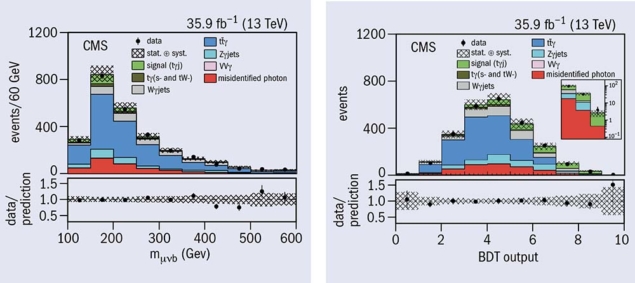
It is well known that the top quark, the heaviest known elementary particle, plays an important role in electroweak-symmetry breaking, and is also one of the most promising particles to be investigated in the search for new physics. Numerous measurements of top-quark interactions have been performed at the Tevatron and LHC since the discovery of this particle at the Tevatron in 1995. The associated production of a top quark with a photon (tγj, where j indicates a jet) via electroweak interactions provides a powerful tool to probe the couplings of the top quark with the photon and the couplings of the W boson with the photon. The small production rate of the tγj process at the LHC makes its observation very challenging. However, any excess observed above the Standard Model (SM) rate would indicate new physics.
The CMS collaboration has released evidence for the tγj process using events with one isolated muon, a photon and jets in the final state. The results are based on proton–proton collision data recorded in 2016 at a centre-of-mass-energy of 13 TeV. The tγj process results in an interesting final state, which requires information from all sub-detectors of the CMS experiment, from the innermost tracker layers to the outermost muon systems.
The predicted cross section for tγj, including the branching fraction, is 81 fb, which corresponds to a few hundred events in the whole dataset. Therefore, a sophisticated method is needed to separate the signal events from the huge number of background events originating from several other SM processes. In addition, to achieve the highest signal-to-background ratio, a robust multivariate technique is used to estimate the contribution of the background in which a jet is misidentified as a photon. After these methods are employed, the largest background contribution comes from events that contain a top-quark pair associated with a photon.
CMS observed an excess of tγj events over the background-only hypothesis with a significance of 4.4 standard deviations, which corresponds to a p-value of 4.3 × 10–6. The measured value of the signal cross section in the considered phase space is 115 ± 34 fb. The measurement is in agreement with the SM prediction within one standard deviation. This result is the first experimental evidence of the direct production of a top quark and a photon. Upcoming results, exploiting the full 13 TeV dataset, will further improve the precision of the measurement.
Further reading
CMS Collaboration 2018 arXiv:1808.02913.







